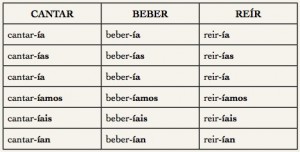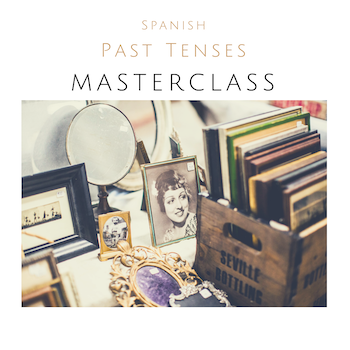- CONDITIONAL
The conditional tense is frequently used to express the probability, possibility, wonder or conjecture and is usually translated as would, could, must have or probably.
FORM
1. The stem is the same as for the future tense, that is, the infinitive form of the verb.
2. The endings are: ía, ías, ía, íamos, íais, ían. Same endings for the 3 conjugations. Look at the example:
The same verbs that are irregular in the future tense are also irregular in the conditional tense. The endings don’t change, but the stem change in the same way it change in the future tense. Check this article for the irregularities.
USE
There are several ways in which the conditional is used in Spanish:
1. To express the future from the perspective of the past.
Estaba seguro de que vendrían.
I was sure they would come.
2. To express conjecture or probability in the past.
Estamos buscando piso. La semana pasada visitaríamos más de 15 apartamentos.
We are looking for a flat. Last week we must have visited more than 15 apartments.
3. For polite use, to indicate softening of a statement or request.
Perdone, ¿podría acercarme este libro de la estantería de arriba? Yo no alcanzo.
Excuse me, could you give that book from the top shelf? I can’t reach it.
4. To express hypothetical actions or events (in present or future times).
Iría a Chile a visitarte si tuviera tiempo, pero tengo que trabajar en la empresa.
I’d go to visit you if I had time, but I have to work in the enterprise.
- CONDITIONAL PERFECT
FORM
The conditional perfect tense is formed with the conditional of the verb “haber” and the past participle.
USE
It is used mainly to express something hypothetical or unreal in the past.
Te habría acompañado al dentista, pero no me avisaste que ibas.
I would have accompanied you to the dentist but you didn’t let me know you were going.
- MAKING HYPOTHESIS
There are 3 types: real, potential or possible, and irreal.
The usual link is “si”, although there are others.
REAL CONDITION
Express facts or actions which may actually come about or, at least, are viewed as a possibility. The conditional clause goes in indicative (never future) and the main clause goes in indicative (present, future).
Si practicas mucho mejorarás.
If you practice a lot you’ll improve.
Si has practicado mucho mejorarás.
If you have practiced a lot you will improve.
Si practicas, mejoras.
If you practice, you improve.
POTENTIAL CONDITION
Shows the facts as unreal in the present or very unlikely in the future. The conditional clause goes in “pretérito imperfecto de subjuntivo” and the main clause in conditional.
Si practicaras más a menudo mejorarías.
If you practiced more often you would improve.
UNREAL CLAUSE
Shows unreal / impossible facts in the past. The conditional clause goes in “pretérito pluscuamperfecto de subjuntivo” and the main clause in conditional perfect.
Si hubieras practicado más habrías mejorado.
If you had practiced more you would have improved.






Pingback: Practical Poetry. Hypothesis, Imperfecto Subjuntivo and Condicional through poetry – Maria Ortega Garcia